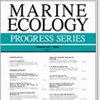南极西部座头鲸新型气泡网觅食策略的使用和流行情况
IF 2.1
3区 环境科学与生态学
Q2 ECOLOGY
引用次数: 0
摘要
摘要:新觅食策略的创新使物种能够根据不断变化的条件优化觅食。座头鲸为这一概念提供了一个很好的研究物种,因为它们在不同环境中的不同种群中使用多种新的觅食策略。气泡网捕食(BNF)常见于北半球,在过去 20 年里,它已成为南极半岛西部的一种觅食创新。利用 2015-2023 年的目击数据,我们发现 BNF 出现在每个研究年份,年均占觅食目击的 30%。在同一研究期间部署的 26 个动物出生标签对这些数据进行了补充。在这些标签中,有 12 个标签检测到了 BNF,在检测到的觅食跳跃中,BNF 平均占 19%。BNF 的出现有季节性趋势,在觅食季节开始时(1 月),BNF 的出现频率明显较高,之后则有所下降。BNF 群体的规模(平均:3.41)明显大于非 BNF 表层觅食群体(平均:2.21)。这一观察结果与北半球的 BNF 一致,后者似乎也主要是一种群体觅食策略。BNF的季节性模式和相对较近的出现表明,它的使用可能与特定的环境条件有关,这一点应通过比较BNF与猎物密度和光照等变量进行研究。新型觅食策略在其他种群中的社会传播进一步表明,这种策略的流行很可能是通过社会学习实现的。本文章由计算机程序翻译,如有差异,请以英文原文为准。
Use and prevalence of novel bubble-net foraging strategy in Western Antarctic humpback whales
ABSTRACT: The innovation of new foraging strategies allows species to optimize their foraging in response to changing conditions. Humpback whales provide a good study species for this concept, as they utilize multiple novel foraging tactics across populations in diverse environments. Bubble-net feeding (BNF), commonly seen in the Northern Hemisphere, has emerged as a foraging innovation in the past 20 yr within the Western Antarctic Peninsula. Using sightings data from 2015-2023, we found that BNF was present in every study year, with an annual average of 30% of foraging sightings. This data was supplemented with 26 animal-born tags deployed over the same study period. Of these tags, 12 detected instances of BNF, with BNF making up an average of 19% of the foraging lunges detected. There were seasonal trends in BNF sightings, as it was observed significantly more often at the beginning of the feeding season (January) before declining. BNF group sizes (mean: 3.41) were significantly larger than non-BNF surface feeding groups (mean: 2.21). This observation is consistent with BNF in the Northern Hemisphere, which also appears to primarily be a group foraging strategy. The seasonal pattern and relatively recent emergence of BNF suggests that its use is likely tied to specific environmental conditions, which should be investigated by comparing BNF with variables such as prey density and light availability. The social transmission of novel foraging strategies across other populations further suggests that the prevalence of this strategy likely occurs through social learning.
求助全文
通过发布文献求助,成功后即可免费获取论文全文。
去求助
来源期刊

Marine Ecology Progress Series
环境科学-海洋学
CiteScore
5.30
自引率
8.00%
发文量
238
审稿时长
3 months
期刊介绍:
The leading journal in its field, MEPS covers all aspects of marine ecology, fundamental and applied. Topics covered include microbiology, botany, zoology, ecosystem research, biological oceanography, ecological aspects of fisheries and aquaculture, pollution, environmental protection, conservation, and resource management.
 求助内容:
求助内容: 应助结果提醒方式:
应助结果提醒方式:


